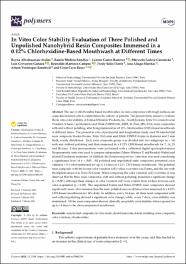Mostrar el registro sencillo del ítem
In Vitro Color Stability Evaluation of Three Polished and Unpolished Nanohybrid Resin Composites Immersed in a 0.12% Chlorhexidine-Based Mouthwash at Different Times
| dc.contributor.author | Allcahuaman-Avalos, Reyna | |
| dc.contributor.author | Cayo-Rojas, César | |
| dc.contributor.author | Medina-Sánchez, Ramín | |
| dc.contributor.author | Castro-Ramirez, Leonor | |
| dc.contributor.author | Ladera-Castañeda, Marysela | |
| dc.contributor.author | Cervantes-Ganoza, Luis | |
| dc.contributor.author | Martínez-Campos, Reynaldo | |
| dc.contributor.author | Solís-Dante, Fredy | |
| dc.contributor.author | Aliaga-Mariñas, Ana | |
| dc.contributor.author | Verástegui-Sandoval, Arturo | |
| dc.date.accessioned | 2023-04-18T15:44:01Z | |
| dc.date.available | 2023-04-18T15:44:01Z | |
| dc.date.issued | 2023-03-07 | |
| dc.identifier.uri | https://hdl.handle.net/20.500.14308/4619 | |
| dc.description.abstract | Abstract: The use of chlorhexidine-based mouthwashes on resin composites with rough surfaces can cause discoloration which compromises the esthetic of patients. The present study aimed to evaluate the in vitro color stability of Forma (Ultradent Products, Inc., South Jordan), Tetric N-Ceram (Ivoclar Vivadent, Schaan, Liechtenstein) and Filtek Z350XT (3M, ESPE, St. Paul, MN, USA) resin composites, with and without polishing, after being immersed in a 0.12% chlorhexidine (CHX)-based mouthwash at different times. The present in vitro experimental and longitudinal study used 96 nanohybrid resin composite blocks (Forma, Tetric N-Ceram and Filtek Z350XT) 8 mm in diameter and 2 mm thick, evenly distributed. Each resin composite group was divided into two subgroups (n = 16) with and without polishing and then immersed in a 0.12% CHX-based mouthwash for 7, 14, 21 and 28 days. Color measurements were performed with a calibrated digital spectrophotometer. Nonparametric tests were used to compare independent (Mann–Whitney U and Kruskal–Wallis) and related (Friedman) measures. In addition, the Bonferroni post hoc correction was used considering a significance level of p < 0.05. All polished and unpolished resin composites presented color variation < 3.3 when immersed for up to 14 days in 0.12% CHX-based mouthwash. The polished resin composite with the lowest color variation (∆E) values over time was Forma, and the one with the highest values was Tetric N-Ceram. When comparing the color variation (∆E) over time, it was observed that the three resin composites, with and without polishing, presented a significant change (p < 0.001), although these changes in color variation (∆E) were evident from 14 days between each color acquisition (p < 0.05). The unpolished Forma and Filtek Z350XT resin composites showed significantly more color variation than the same polished ones at all times when immersed in a 0.12% CHX-based mouthwash for 30 s daily. In addition, every 14 days, all three resin composites with and without polishing showed a significant color change, while, every 7 days, color stability was maintained. All the resin composites showed clinically acceptable color stability when exposed for up to 14 days to the above-mentioned mouthwash. | es_PE |
| dc.format | application/pdf | es_PE |
| dc.language.iso | eng | es_PE |
| dc.publisher | Polymers | es_PE |
| dc.rights | info:eu-repo/semantics/openAccess | es_PE |
| dc.rights.uri | https://creativecommons.org/licenses/by/4.0/ | es_PE |
| dc.subject | Compuesto nanohíbrido | es_PE |
| dc.subject | Estudio in vitro | es_PE |
| dc.subject | Materiales dentales | es_PE |
| dc.subject | Pulido dental | es_PE |
| dc.subject | Compuesto de resina | es_PE |
| dc.subject | Variación de color | es_PE |
| dc.subject | Clorhexidina | es_PE |
| dc.title | In Vitro Color Stability Evaluation of Three Polished and Unpolished Nanohybrid Resin Composites Immersed in a 0.12% Chlorhexidine-Based Mouthwash at Different Times | es_PE |
| dc.type | info:eu-repo/semantics/article | es_PE |
| dc.subject.ocde | https://purl.org/pe-repo/ocde/ford#3.02.14 | es_PE |
| dc.publisher.country | CH | es_PE |
| dc.identifier.doi | https://doi.org/10.3390/polym15061339 |


